инструкцияHyundai H-1 Grand Starex (2010)

РУКОВОДСТВО ПО
ЭКСПЛУАТАЦИИ
Эксплуатация
Техническое обслуживание
Технические характеристики
Вся информация в настоящем Руководстве по эксплуатации приведена по
состоянию на момент публикации.
Компания Hyundai оставляет за собой право в любое время вносить изменения
в рамках постоянно действующей программы модернизации продукции.
Настоящее Руководство применимо для всех моделей автомобилей Hyundai и
содержит описания как дополнительного, так и стандартного оборудования, а
также соответствующие пояснения. Поэтому в данном Руководстве Вы сможете
обнаружить материалы, не имеющие отношения к конкретной модели Вашего
автомобиля.
Посмотреть инструкция для Hyundai H-1 Grand Starex (2010) бесплатно. Руководство относится к категории автомобили, 2 человек(а) дали ему среднюю оценку 7.6. Руководство доступно на следующих языках: русский. У вас есть вопрос о Hyundai H-1 Grand Starex (2010) или вам нужна помощь? Задайте свой вопрос здесь

Главная
Не можете найти ответ на свой вопрос в руководстве? Вы можете найти ответ на свой вопрос ниже, в разделе часто задаваемых вопросов о Hyundai H-1 Grand Starex (2010).
Не нашли свой вопрос? Задайте свой вопрос здесь

Купить полную версию книги
>
1. ТЕХНИЧЕСКАЯ ИНФОРМАЦИЯ АВТОМОБИЛЯ
СЕРИЙНЫЙ НОМЕР АВТОМОБИЛЯ (VIN)
Серийный номер автомобиля это номер, который используется при регистрации Вашего транспортного средства и применяется во всех правовых случаях, относящихся к вопросам прав собственности на автомобиль и т. д.
СЕРТИФИКАЦИОННАЯ ТАБЛИЧКА
Сертификационная табличка находится на внешней стороне средней стойки со стороны водителя (или переднего пассажира) и содержит серийный номер автомобиля (VIN).
ТАБЛИЧКА ТЕХНИЧЕСКИХ ХАРАКТЕРИСТИК/ЗНАЧЕНИЙ ДАВЛЕНИЯ В ШИНАХ
Установленные на Вашем автомобиле шины выбраны для обеспечения наилучших характеристик управляемости автомобиля. Табличка технических характеристик шин находится на внешней панели средней стойки со стороны водителя и содержит информацию о рекомендуемом давлении в шинах Вашего автомобиля.
Серийный номер двигателя выбит на блоке цилиндров, как показано на рисунке.
| Параметр | мм |
| Общая длина | 5125 |
| Общая ширина | 1920 |
| Общая высота | 1925 |
| Колея передних колес | 1685 |
| Колея задних колес | 1660 |
| Колесная база | 3200 |
Примечание:
Указанные выше размеры приведены для 12-местного/8-местного автомобиля.
| Тип лампы | Мощность, Вт |
| Фары (ближний свет/дальний свет) | 55/55 |
| Передние указатели поворотов | 21 |
| Тип лампы | Мощность, Вт |
| Габаритный фонарь | 5 |
| Боковой повторитель указателя поворотов* | 5 |
| Передние противотуманные фары* | 27 |
| Задняя противотуманная фара* | 21 |
| Стоп-сигнал и задний габаритный фонарь | 21/5 |
| Задние указатели поворота | 21 |
| Фонари заднего хода | 16 |
| Высокорасположенный повторитель стоп-сигнала | 5 |
| Лампы освещения номерного знака | 5 |
| Центральная потолочная лампа | 10 |
| Лампа багажного отсека* | 10 |
| Лампа освещения подножки* | 5 |
Примечание:
* При наличии.
| Наименование | Размер шины | Размер колеса | Давление в шине, бар (кПа) | Момент затяжки гайки крепления колеса кг-м (Н-м) | |||||
| Универсал | Минивэн | ||||||||
| Номинальная нагрузка | Максимальная нагрузка | ||||||||
| Передняя | Задняя | Передняя | Задняя | Передняя | Задняя | ||||
| Полноразмерная шина | 215/70R16 | 6.5Jx16 | 2,9 (290) | 3,25 (325) | 2,9 (290) | 3,5 (350) | 2,9 (290) | 3,5 (350) | 9-11 (88-107) |
Примечание:
* Номинальная нагрузка — до трех человек.
РЕКОМЕНДУЕМЫЕ СМАЗОЧНЫЕ МАТЕРИАЛЫ И ИНФОРМАЦИЯ ОБ ОБЪЕМАХ
Для достижения оптимального режима работы двигателя и трансмиссии, а также увеличения их сроков службы, используйте только качественные смазочные материалы. Качественные смазочные материалы также влияют на эффективность работы двигателя и снижают расход топлива. На Вашем автомобиле рекомендуется использовать следующие смазочные материалы и жидкости.
| Смазочный материал | Объем | Классификация | ||
| Моторное масло*1*2 (слив и заливка) Рекомендуется HELiX Motor oils | Дизельный двигатель*3 | А2.5 | 7,4/(7,82 US) | VGT*3: API Service CH-4 или выше, ACEA B4 WGT*4: API Service CF-4 или выше, ACEA B4 |
| 4D56 | 5,4/(5,71 US) | API Service CF-4 или выше, ACEA B2 или ВЗ | ||
| Бензиновый двигатель | 4,3/(4,54 US) | API Service SJ, SL или выше, ILSAC GF-3 или выше | ||
| Масло механической коробки передач | Дизельный двигатель А2.5 | 3,2/(3,38 US) | API Service GL-4 (SAE 75W/85) | |
| Дизельный двигатель 4D56/ Бензиновый двигатель | 1,95/(2,06 US) | |||
| Жидкость автоматической коробки передач | Дизельный двигатель А2.5 | 10,0/(10,60 US) | APOLLOILATF RED-1 | |
| Дизельный двигатель 4D56/ Бензиновый двигатель | 8,0/(8,45 US) | CASTLE AUTO FLUID T-IV, DIAMOND ATFSP-I | ||
| Усилитель рулевого управления | 0,9-1,0/(0,95-1,06 US) | PSF-3 | ||
| Жидкость системы охлаждения | Универсал | 13/(13,74 US) | Смесь антифриза и воды (Охлаждающая жидкость на основе этиленгликоля для алюминиевого радиатора) | |
| Минивэн | 10/(10,57 US) | |||
| Тормозная жидкость | 0,7-0,8/(0,7-0,8 US) | FMVSS116 DOT-3 или DOT-4 | ||
| Масло редуктора заднего моста | 1,8-2,4/(1,9-2,54 US) | Зона умеренного климата (-30 °С~30 °С): APIGL-4 (SAE90). Зона жаркого климата (свыше +30 °С): APIGL-4 (SAE140). Зона холодного климата (ниже -30 °С): API GL-5 (SAE 80). |
||
| Топливо | 75/(79,25 US) | — |
Примечание:
*1 Смотрите рекомендованный индекс вязкости по SAE.
*2 В настоящее время в наличии имеется масло с маркировкой Energy Conserving Oil (энергосберегающее моторное масло). Помимо прочих положительных эффектов, применение такого масла способствует экономии расхода топлива за счет сокращения потребления топлива, необходимого для преодоления трения деталей двигателя. Зачастую эти улучшения трудно оценить при ежедневном вождении, однако суммарная экономия средств и энергии за год оказывается внушительной.
*3 W.G.T — турбонагнетатель с перепускным клапаном.
*4 V.G.T — турбонагнетатель изменяемой геометрии.
РЕКОМЕНДУЕМЫЕ ЗНАЧЕНИЯ КОЭФФИЦИЕНТА ВЯЗКОСТИ ПО КЛАССИФИКАЦИИ SAE
ВНИМАНИЕ
Обязательно убедитесь в чистоте пространства вокруг крышки любой заливной горловины, сливного отверстия и масляного щупа перед проверкой уровня масла или его заменой. Это особенно важно при эксплуатации транспортного средства в пыльных и загрязненных условиях и при езде по грунтовым дорогам. Очистка крышки и щупа предотвратит попадание пыли и песка в двигатель и другие механизмы, которые могут быть повреждены.
Вязкость моторного масла влияет на расход топлива и на эксплуатацию в холодную погоду (запуск двигателя и подача масла). Моторное масло низкой вязкости обеспечивает лучший уровень экономии топлива и лучшую работу двигателя в холодную погоду, а масло с высоким коэффициентом вязкости необходимо для требуемого уровня смазки двигателя в жарких условиях. Использование масел со значениями коэффициентов вязкости, отличными от рекомендуемых, может привести к выходу двигателя из строя. При выборе типа масла, принимайте во внимание диапазон температур, в котором будет эксплуатироваться Ваш автомобиль до следующей замены масла. Выбирайте рекомендуемые значения коэффициента вязкости из таблицы.
Примечание:
*1 Для лучшей экономии топлива рекомендуется использовать моторное масло с коэффициентом вязкости по классификации SAE 5W-20, 5W-30 (API SJ, SL/ILSAC GF-3). Однако если данные марки масел недоступны в стране эксплуатации Вашего автомобиля, выбирайте подходящее масло, руководствуясь табличными значениями коэффициентов вязкости.
*2 Предназначено для использования в условиях крайне низких температур, его применение ограничено условиями эксплуатации и географическим положением (особенно не рекомендуется длительная эксплуатация с максимальной нагрузкой и эксплуатация на высоких скоростях).
РУКОВОДСТВО ПО
ЭКСПЛУАТАЦИИ
Эксплуатация
Техническое обслуживание
Технические характеристики
Вся информация в настоящем Руководстве по эксплуатации приведена по
состоянию на момент публикации.
Компания Hyundai оставляет за собой право в любое время вносить изменения
в рамках постоянно действующей программы модернизации продукции.
Настоящее Руководство применимо для всех моделей автомобилей Hyundai и
содержит описания как дополнительного, так и стандартного оборудования, а
также соответствующие пояснения. Поэтому в данном Руководстве Вы сможете
обнаружить материалы, не имеющие отношения к конкретной модели Вашего
автомобиля.
Вся представленная на сайте информация, касающаяся автомобилей и сервисного
обслуживания, носит информационный характер и не является публичной офертой,
определяемой положениями ст. 437 (2) ГК РФ. Все цены, указанные на данном
сайте, носят информационный характер и являются максимально рекомендуемыми розничными
ценами по расчётам дистрибьютора (ООО «Хендэ Мотор СНГ»). Для получения
подробной информации просьба обращаться к ближайшему официальному дилеру ООО «Хендэ
Мотор СНГ». Опубликованная на данном сайте информация может быть изменена в любое
время без предварительного уведомления.
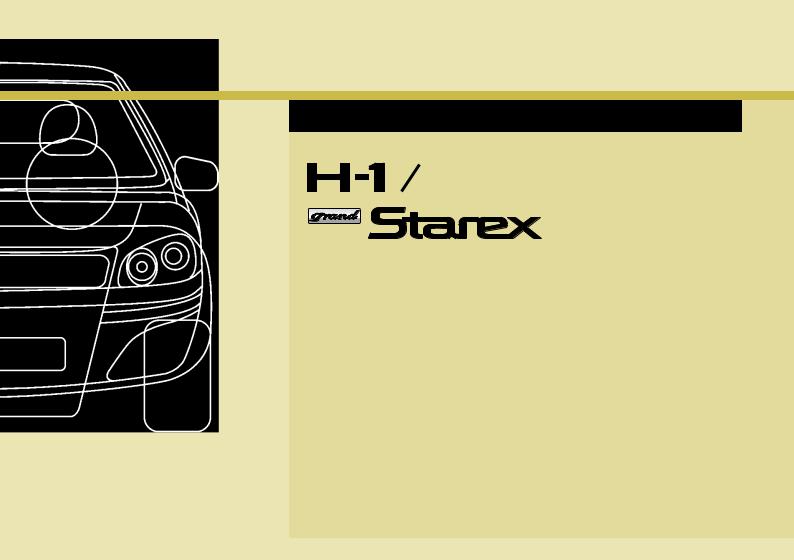
OWNER’S MANUAL
Operation
Maintenance
Specifications
All information in this Owner’s Manual is current at the time of publication. However, Hyundai reserves the right to make changes at any time so that our policy of continual product improvement may be carried out.
This manual applies to all models of this vehicle and includes descriptions and explanations of optional as well as standard equipment. As a result, you may find material in this manual that does not apply to your specific vehicle.
Please note that some models are equipped with Right-Hand Drive (RHD). The explanations and illustrations for some operations in RHD models are opposite of those written in this manual.
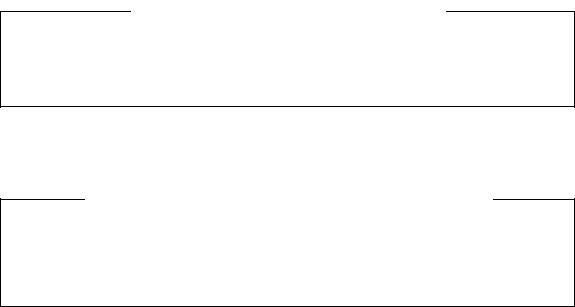
CAUTION: MODIFICATIONS TO YOUR HYUNDAI
Your Hyundai should not be modified in any way. Such modifications may adversely affect the performance, safety or durability of your Hyundai and may, in addition, violate conditions of the limited warranties covering the vehicle. Certain modifications may also be in violation of regulations established by the Department of Transportation and other government agencies in your country.
TWO-WAY RADIO OR CELLULAR TELEPHONE INSTALLATION
Your vehicle is equipped with electronic fuel injection and other electronic components. It is possible for an improperly installed/adjusted two-way radio or cellular telephone to adversely affect electronic systems. For this reason, we recommend that you carefully follow the radio manufacturer’s instructions or consult your Hyundai dealer for precautionary measures or special instructions if you choose to install one of these devices.
F2
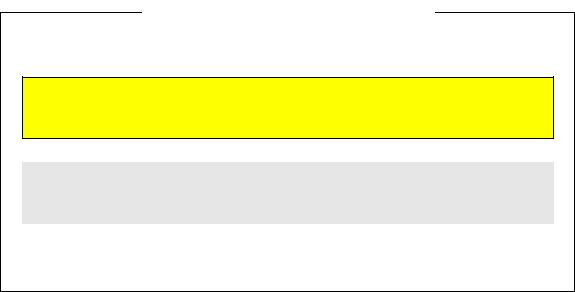
SAFETY AND VEHICLE DAMAGE WARNING
This manual includes information titled as WARNING, CAUTION and NOTICE.
These titles indicate the following:

This indicates that a condition may result in harm, serious injury or death to you or other persons if the warning is not heeded. Follow the advice provided with the warning.

This indicates that a condition may result in damage to your vehicle or its equipment if the caution is not heeded. Follow the advice provided with the caution.
NOTICE
This indicates that interesting or helpful information is being provided.
F3
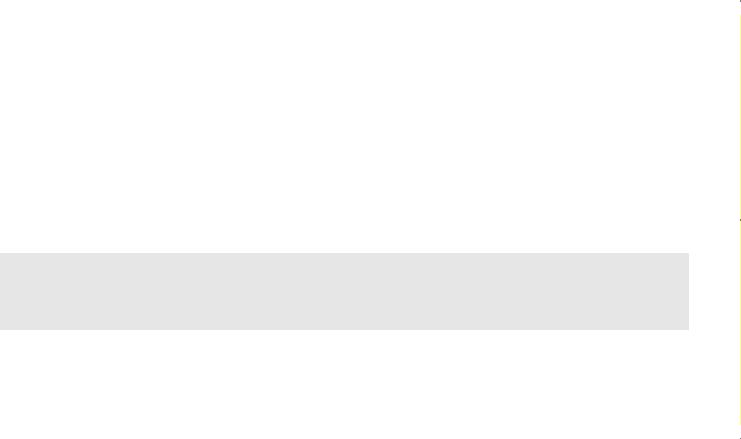
FOREWORD
Thank you for choosing Hyundai. We are pleased to welcome you to the growing number of discriminating people who drive Hyundais. The advanced engineering and high-quality construction of each Hyundai we build is something of which we’re very proud.
Your Owner’s Manual will introduce you to the features and operation of your new Hyundai. It is suggested that you read it carefully because the information it contains can contribute greatly to the satisfaction you receive from your new car.
The manufacturer also recommends that service and maintenance on your vehicle be performed by an authorized Hyundai dealer.
HYUNDAI MOTOR COMPANY
Note : Because future owners will also need the information included in this manual, if you sell this Hyundai, please leave the manual in the vehicle for their use. Thank you.

Severe engine and transmission damage may result from the use of poor quality fuels and lubricants that do not meet Hyundai specifications. You must always use high quality fuels and lubricants that meet the specifications listed on Page 9-4 in the Vehicle Specifications section of the Owner’s Manual.
Copyright 2014 Hyundai Motor Company. All rights reserved. No part of this publication may be reproduced, stored in any retrieval system or transmitted in any form or by any means without the prior written permission of Hyundai Motor Company.
F4

|
Introduction |
1 |
||||
|
Your vehicle at a glance |
2 |
||||
|
Safety features of your vehicle |
3 |
||||
|
Features of your vehicle |
4 |
||||
table of contents |
Driving your vehicle |
5 |
|||
|
What to do in an emergency |
6 |
||||
|
Maintenance |
7 |
||||
|
Consumer information |
8 |
||||
|
Specifications |
9 |
||||
|
Index |
I |
||||
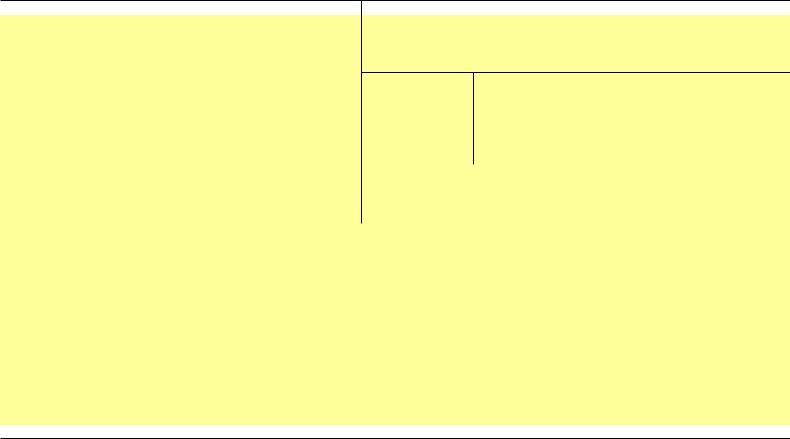
How to use this manual / 1-2
Fuel requirements / 1-2
Vehicle handling instructions / 1-6
Vehicle break-in process / 1-6
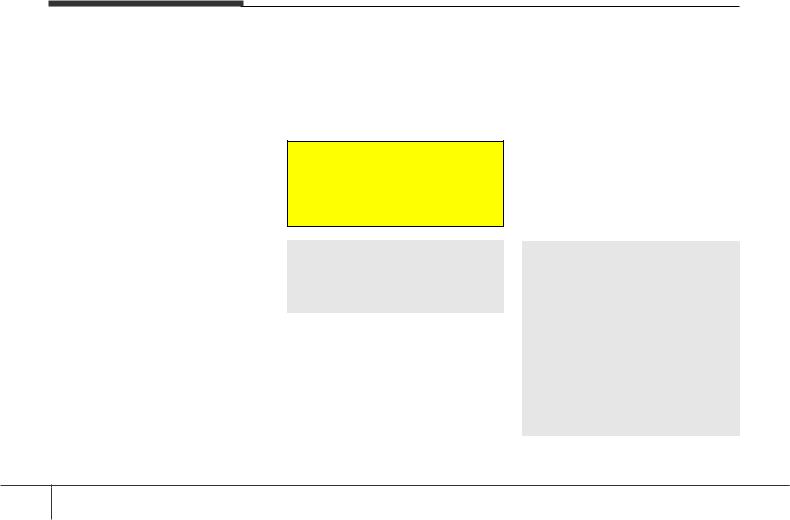
Introduction
HOW TO USE THIS MANUAL
A010000AUN
We want to help you get the greatest possible driving pleasure from your vehicle. Your Owner’s Manual can assist you in many ways. We strongly recommend that you read the entire manual. In order to minimize the chance of death or injury, you must read the WARNING and CAUTION sections in the manual.
Illustrations complement the words in this manual to best explain how to enjoy your vehicle. By reading your manual, you learn about features, important safety information, and driving tips under various road conditions.
The general layout of the manual is provided in the Table of Contents. A good place to start is the index; it has an alphabetical listing of all information in your manual.
Sections: This manual has nine sections plus an index. Each section begins with a brief list of contents so you can tell at a glance if that section has the information you want.
You will find various WARNINGs, CAUTIONs, and NOTICEs in this manual. These WARNINGs were prepared to enhance your personal safety. You should carefully read and follow ALL procedures and recommendations provided in these WARNINGs, CAUTIONs and NOTICEs.

A WARNING indicates a situation in which harm, serious bodily injury or death could result if the warning is ignored.

A CAUTION indicates a situation in which damage to your vehicle could result if the caution is ignored.
NOTICE
A NOTICE indicates interesting or helpful information is being provided.
FUEL REQUIREMENTS
Gasoline engine
A020101AEN
Unleaded
Your new HYUNDAI vehicle is designed to use only unleaded fuel having an Octane Rating of RON (Research Octane Number) 91/AKI (Anti-Knock Index) 87 or higher. (Do not use methanol blended fuels.)
Your new vehicle is designed to obtain maximum performance with UNLEADED FUEL, as well as minimize exhaust emissions and spark plug fouling.

NEVER USE LEADED FUEL. The use of leaded fuel is detrimental to the catalytic converter and will damage the engine control system’s oxygen sensor and affect emission control.
Never add any fuel system cleaning agents to the fuel tank other than what has been specified. (We recommend that the system be consulted by an authorized HYUNDAI dealer.
1 2
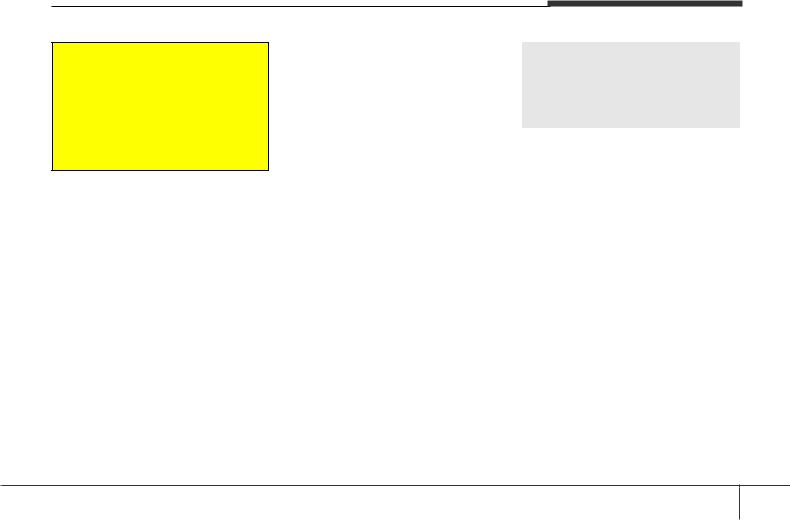
Introduction

•Do not «top off» after the nozzle automatically shuts off when refueling.
•Always check that the fuel cap is installed securely to prevent fuel spillage in the event of an accident.
A020102AEN
Leaded (if equipped)
For some countries, your vehicle is designed to use leaded gasoline. When you are going to use leaded gasoline, we recommend that you ask an authorized HYUNDAI dealer.
Octane Rating of leaded gasoline is same with unleaded one.
A020103AUN
Gasoline containing alcohol and methanol
Gasohol, a mixture of gasoline and ethanol (also known as grain alcohol), and gasoline or gasohol containing methanol (also known as wood alcohol) are being marketed along with or instead of leaded or unleaded gasoline.
Do not use gasohol containing more than 10% ethanol, and do not use gasoline or gasohol containing any methanol. Either of these fuels may cause drivability problems and damage to the fuel system, engine control system and emission control system.
Discontinue using gasohol of any kind if drivability problems occur.
Vehicle damage or drivability problems may not be covered by the manufacturer’s warranty if they result from the use of:
1.Gasohol containing more than 10% ethanol.
2.Gasoline or gasohol containing methanol.
3.Leaded fuel or leaded gasohol.

Never use gasohol which contains methanol. Discontinue use of any gasohol product which impairs drivability.
Other fuels
Using fuels such as;
—Silicone (Si) contained fuel,
—MMT (Manganese, Mn) contained fuel,
—Ferrocene (Fe) contained fuel, and
—Other metalic additives contained fuels,
may cause vehicle and engine damage or cause plugging, misfiring, poor acceleration, engine stalling, catalyst melting, abnormal corrosion, life cycle reduction, etc.
Also, the Malfunction Indicator Lamp (MIL) may illuminate.
NOTICE
Damage to the fuel system or performance problem caused by the use of these fuels may not be covered by your New Vehicle Limited Warranty.
1 3
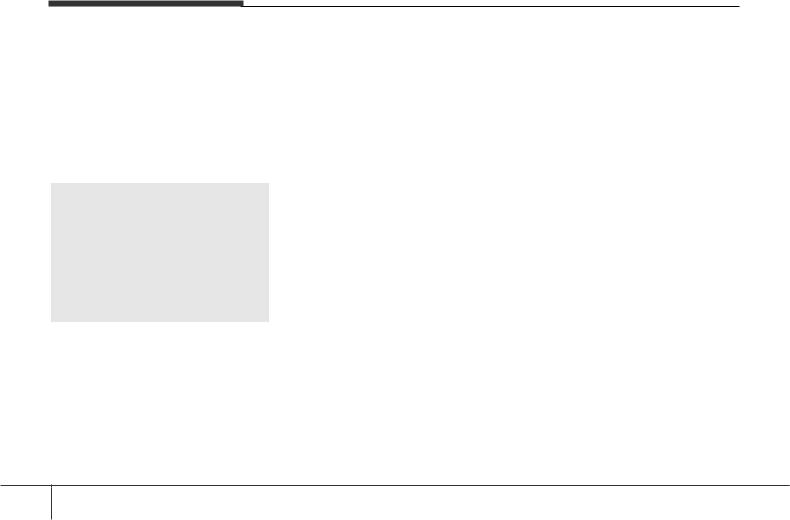
Introduction
A020104AEN
Use of MTBE
HYUNDAI recommends avoiding fuels containing MTBE (Methyl Tertiary Butyl Ether) over 15.0% vol. (Oxygen Content 2.7% weight) in your vehicle.
Fuel containing MTBE over 15.0% vol. (Oxygen Content 2.7% weight) may reduce vehicle performance and produce vapor lock or hard starting.

Your New Vehicle Limited Warranty may not cover damage to the fuel system and any performance problems that are caused by the use of fuels containing methanol or fuels containing MTBE (Methyl Tertiary Butyl Ether) over 15.0% vol. (Oxygen Content 2.7% weight.)
A020105AUN
Do not use methanol
Fuels containing methanol (wood alcohol) should not be used in your vehicle. This type of fuel can reduce vehicle performance and damage components of the fuel system, engine control system and emission control system.
Fuel Additives
HYUNDAI recommends that you use unleaded gasoline which has an octane rating of RON(Research
Octane Number) 95 / AKI (Anti Knock Index) 91 or higher (for Europe) or Octane Rating of RON (Research Octane Number) 91 / AKI (Anti-Knock Index) 87 or higher (except Europe).
For customers who do not use good quality gasoline including fuel additives regularly, and have problems starting or the engine does not run smoothly, one bottle of additives added to the fuel tank at every 15,000km (for Europe)/5,000km (except Europe). Additives are available from your authorized HYUNDAI dealer along with information on how to use them.
A020107AUN
Operation in foreign countries
If you are going to drive your vehicle in another country, be sure to:
•Observe all regulations regarding registration and insurance.
•Determine that acceptable fuel is available.
Diesel engine
A020201DUN
Diesel fuel
Diesel engine must be operated only on commercially available diesel fuel that complies with EN 590 or comparable standard. (EN stands for «European Norm»).
Do not use marine diesel fuel, heating oils, or non-approved fuel additives, as this will increase wear and cause damage to the engine and fuel system.
The use of non-approved fuels and/or fuel additives will result in a limitation of your warranty rights.
Diesel fuel of above cetane 51 is used in your vehicle. If two types of diesel fuel are available, use summer or winter fuel properly according to the following temperature conditions.
•Above -5°C (23°F) … Summer type diesel fuel.
•Below -5°C (23°F) … Winter type diesel fuel.
Watch the fuel level in the tank very carefully : If the engine stops through fuel failure, the circuits must be completely purged to permit restarting.
1 4


Do not let any gasoline or water enter the tank. This would make it necessary to drain it out and to bleed the lines to avoid jamming the injection pump and damaging the engine.
CAUTION — Diesel Fuel (if equipped with DPF)
It is recommended to use the regulated automotive diesel fuel for diesel vehicle equipped with the DPF system.
If you use diesel fuel including high sulfur (more than 50 ppm sulfur) and unspecified additives, it can cause the DPF system to be damaged and white smoke can be emitted.
Introduction
A020202BUN
Biodiesel
Commercially supplied Diesel blends of no more than 7% biodiesel, commonly known as «B7 Diesel» may be used in your vehicle if Biodiesel meets EN 14214 or equivalent specifications. (EN stands for «European Norm»). The use of biofuels exceeding 7% made from rapeseed methyl ester (RME), fatty acid methyl ester (FAME), vegetable oil methyl ester (VME) etc. or mixing diesel exceeding 7% with biodiesel will cause increased wear or damage to the engine and fuel system. Repair or replacement of worn or damaged components due to the use of non approved fuels will not be covered by the manufactures warranty.
A020202AUN
Biodiesel (for New Zealand)
Commercially supplied Diesel blends of no more than 7% biodiesel, commonly known as «B7 Diesel» may be used in your vehicle if Biodiesel meets EN 14214 or equivalent specifications. (EN stands for «European Norm»). The use of biofuels exceeding 7%, made from rapeseed methyl ester (RME), vegetable oil methyl ester (VME) etc. or mixing diesel exceeding 7% with biodiesel will cause increased wear or damage to the engine and fuel system. Repair or replacement of worn or damaged components due to the use of non approved fuels will not be covered by the manufactures warranty.

•Never use any fuel, whether diesel, B7 biodiesel or otherwise, that fails to meet the latest petroleum industry specification.
•Never use any fuel additives or treatments that are not recommended or approved by the vehicle manufacturer.
1 5
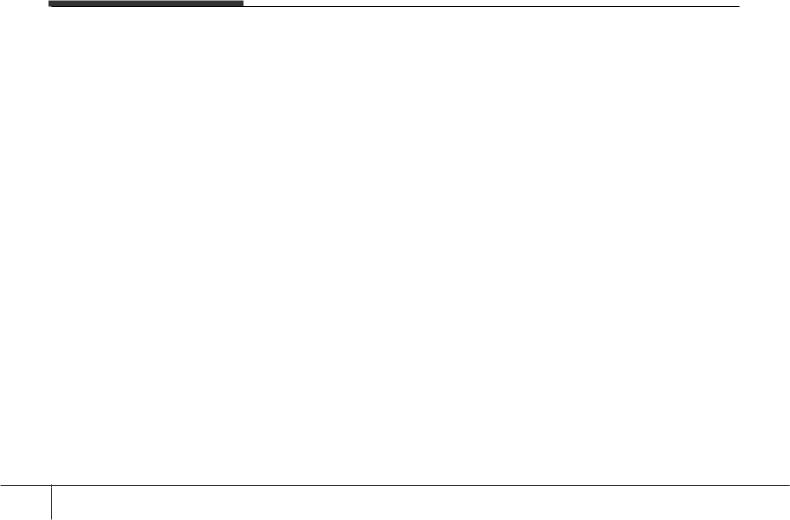
Introduction
VEHICLE HANDLING
INSTRUCTIONS
A090000AEN
As with other vehicles of this type, failure to operate this vehicle correctly may result in loss of control, an accident or vehicle rollover.
Specific design characteristics (higher ground clearance, track, etc.) give this vehicle a higher center of gravity than other types of vehicles. In other words they are not designed for cornering at the same speeds as conventional 2-wheel drive vehicles. Avoid sharp turns or abrupt maneuvers. Again, failure to operate this vehicle correctly may result in loss of control, an accident or vehicle rollover. Be sure to read the “Reducing the risk of a rollover” driving guidelines, in section 5 of this manual.
VEHICLE BREAK-IN PROCESS
A030000AUN
No special break-in period is needed. By following a few simple precautions for the first 1,000 km (600 miles) you may add to the performance, economy and life of your vehicle.
•Do not race the engine.
•While driving, keep your engine speed (rpm, or revolutions per minute) between 2,000 rpm and 4,000 rpm.
•Do not maintain a single speed for long periods of time, either fast or slow. Varying engine speed is needed to properly break-in the engine.
•Avoid hard stops, except in emergencies, to allow the brakes to seat properly.
•Don’t tow a trailer during the first 2,000 km (1,200 miles) of operation.
1 6

Your vehicle at a glance |
2 |
|||
|
Interior overview / 2-2 |
||||
|
Instrument panel overview / 2-4 |
||||
|
Engine compartment / 2-6 |
||||
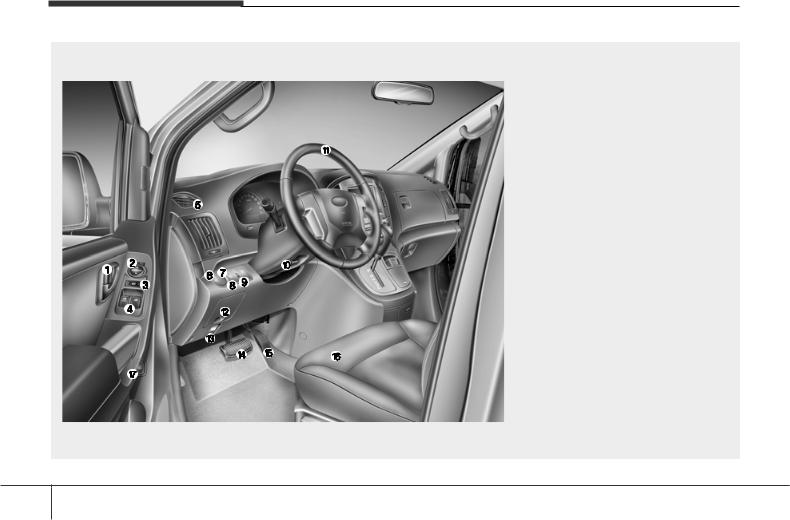
Your vehicle at a glance
INTERIOR OVERVIEW
Left-Hand drive type
|
1. |
Door lock/unlock button* ………………. |
4-10 |
|
2. |
Outside rearview mirror control |
|
|
switch*……………………………………….. |
4-30 |
|
|
3. |
Central door lock switch* ……………… |
4-11 |
|
4. Power window switches*………………. |
4-16 |
|
|
5. |
Air vent………………………………………. |
4-63 |
|
6. |
Front fog light switch*…………………… |
4-53 |
|
7. |
Rear fog light switch* ………………….. |
4-53 |
|
8. |
Head lamp leveling device*…………… |
4-54 |
|
9. |
Instrument panel illumination control |
|
|
knob*…………………………………………. |
4-33 |
|
10. |
Steering wheel tilt control* ………….. |
4-27 |
|
11. |
Steering wheel ………………………….. |
4-26 |
|
12. Fuse box ………………………………….. |
7-55 |
|
|
13. |
Hood release lever…………………….. |
4-21 |
|
14. Brake pedal………………………………. |
5-19 |
|
|
15. |
Accelerator pedal ………………………… |
5-6 |
|
16. |
Seat…………………………………………… |
3-2 |
|
17. |
Fuel filler lid release button…………. |
4-23 |
|
* : if equipped |
OTQ027001G
B010000ATQ
2 2
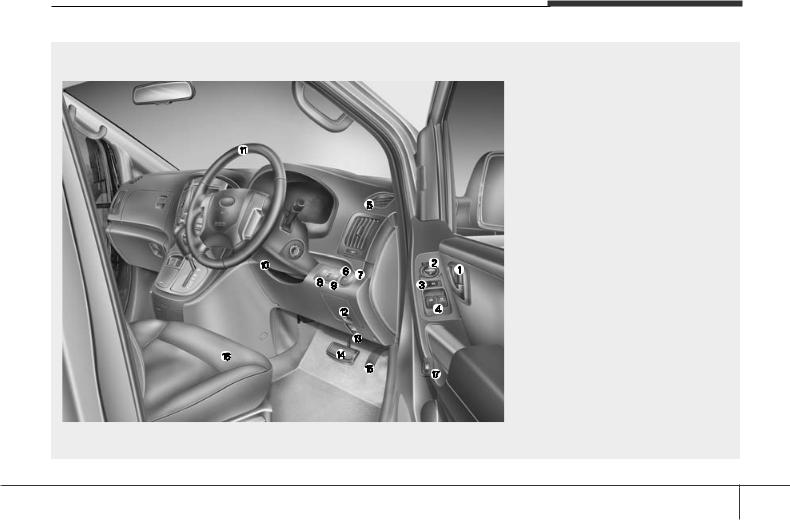
Your vehicle at a glance
Right-Hand drive type
|
1. |
Door lock/unlock button* ………………. |
4-10 |
|
2. |
Outside rearview mirror control |
|
|
switch*……………………………………….. |
4-30 |
|
|
3. |
Central door lock switch* ……………… |
4-11 |
|
4. Power window switches*………………. |
4-16 |
|
|
5. |
Air vent………………………………………. |
4-63 |
|
6. |
Front fog light switch*…………………… |
4-53 |
|
7. |
Rear fog light switch* ………………….. |
4-53 |
|
8. |
Head lamp leveling device*…………… |
4-54 |
|
9. |
Instrument panel illumination control |
|
|
knob*…………………………………………. |
4-33 |
|
10. |
Steering wheel tilt control* ………….. |
4-27 |
|
11. |
Steering wheel ………………………….. |
4-26 |
|
12. Fuse box ………………………………….. |
7-55 |
|
|
13. |
Hood release lever…………………….. |
4-21 |
|
14. Brake pedal………………………………. |
5-19 |
|
|
15. |
Accelerator pedal ………………………… |
5-6 |
|
16. |
Seat…………………………………………… |
3-2 |
|
17. |
Fuel filler lid release button…………. |
4-23 |
|
* : if equipped |
OTQ027001R
B010000ATQ-EA
2 3
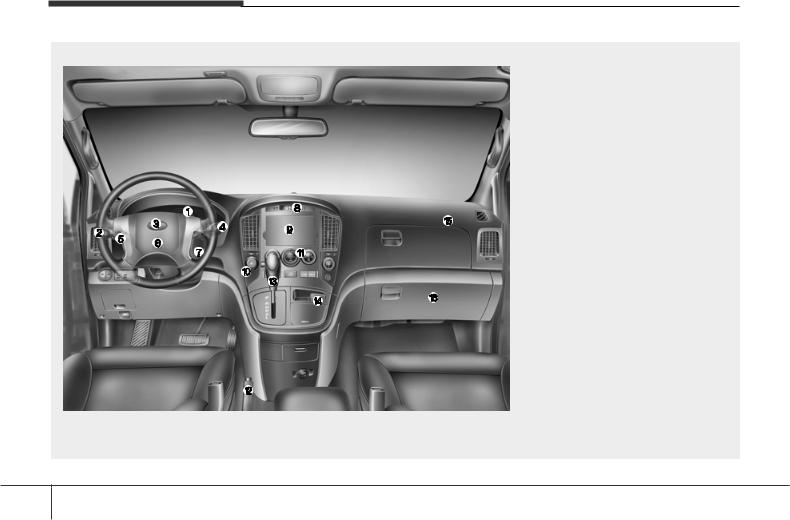
Your vehicle at a glance
INSTRUMENT PANEL OVERVIEW
Left-Hand drive type
|
1. |
Instrument cluster……………………….. |
4-32 |
|
2. |
Light control / Turn signals …………… |
4-50 |
|
3. Horn …………………………………………. |
4-27 |
|
|
4. Wiper/Washer…………………………….. |
4-55 |
|
|
5. |
Steering wheel audio controls* …….. |
4-83 |
|
6. |
Driver’s front air bag* ………………….. |
3-44 |
|
7. |
Ignition switch………………………………. |
5-4 |
|
8. |
Digital clock* ……………………………… |
4-80 |
|
9. |
Audio*……………………………………….. |
4-82 |
|
10. Hazard warning flasher |
||
|
switch ……………………………….. |
4-50, 6-2 |
|
|
11. |
Climate control system* …………….. |
4-61 |
|
12. |
Parking brake …………………………… |
5-20 |
|
13. |
Shift lever ………………………….. |
5-12, 5-9 |
|
14. AUX, USB and iPod port* ………….. |
4-84 |
|
|
15. |
Passenger’s front air bag* ………….. |
3-44 |
|
16. Glove box ………………………………… |
4-74 |
|
|
* : if equipped |
OTQ027002G
B020000BTQ
2 4
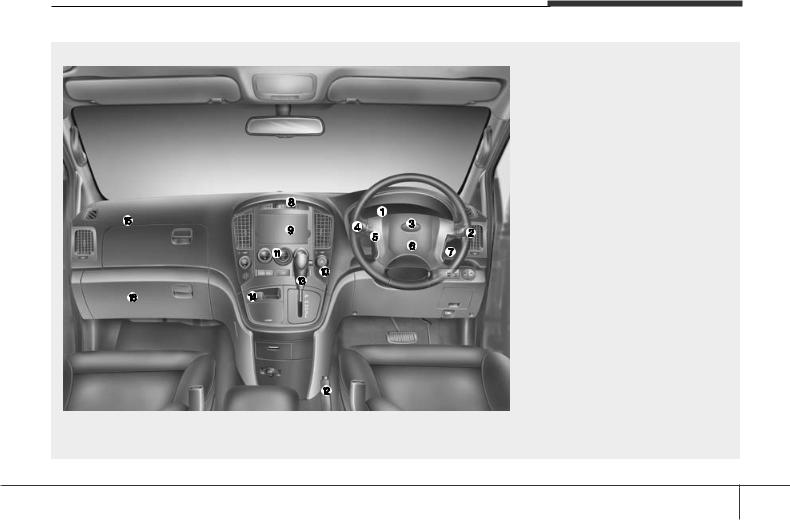
Your vehicle at a glance
Right-Hand drive type
|
1. |
Instrument cluster……………………….. |
4-32 |
|
2. |
Light control / Turn signals …………… |
4-50 |
|
3. Horn …………………………………………. |
4-27 |
|
|
4. Wiper/Washer…………………………….. |
4-55 |
|
|
5. |
Steering wheel audio controls* …….. |
4-83 |
|
6. |
Driver’s front air bag* ………………….. |
3-44 |
|
7. |
Ignition switch………………………………. |
5-4 |
|
8. |
Digital clock* ……………………………… |
4-80 |
|
9. |
Audio*……………………………………….. |
4-82 |
|
10. Hazard warning flasher |
||
|
switch ……………………………….. |
4-50, 6-2 |
|
|
11. |
Climate control system* …………….. |
4-61 |
|
12. |
Parking brake …………………………… |
5-20 |
|
13. |
Shift lever ………………………….. |
5-12, 5-9 |
|
14. AUX, USB and iPod port* ………….. |
4-84 |
|
|
15. |
Passenger’s front air bag* ………….. |
3-44 |
|
16. Glove box ………………………………… |
4-74 |
|
|
* : if equipped |
OTQ027002R
B020000BTQ
2 5
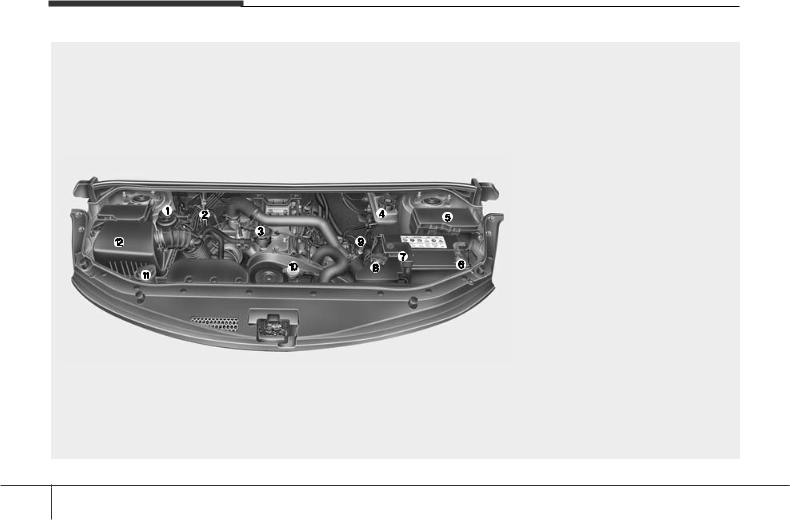
Your vehicle at a glance
ENGINE COMPARTMENT
|
1. |
Power steering fluid reservoir ……….. |
7-30 |
|
2. |
Automatic transmission fluid |
|
|
dipstick*……………………………………… |
7-31 |
|
|
3. |
Engine oil filler cap ……………………… |
7-25 |
|
4. |
Brake fluid reservoir…………………….. |
7-29 |
|
5. Fuse box ……………………………………. |
7-56 |
|
|
6. |
Negative battery terminal……………… |
7-41 |
|
7. |
Positive battery terminal ………………. |
7-41 |
|
8. |
Engine coolant reservoir ………………. |
7-27 |
|
9. |
Engine oil dipstick ……………………….. |
7-25 |
|
10. Radiator cap …………………………….. |
7-28 |
|
|
11. Windshield washer fluid reservoir … |
7-33 |
|
|
12. Air cleaner………………………………… |
7-35 |
|
|
* : if equipped |
* The actual engine room in the vehicle may differ from the illustration.
OTQ077001
B030000ATQ
2 6
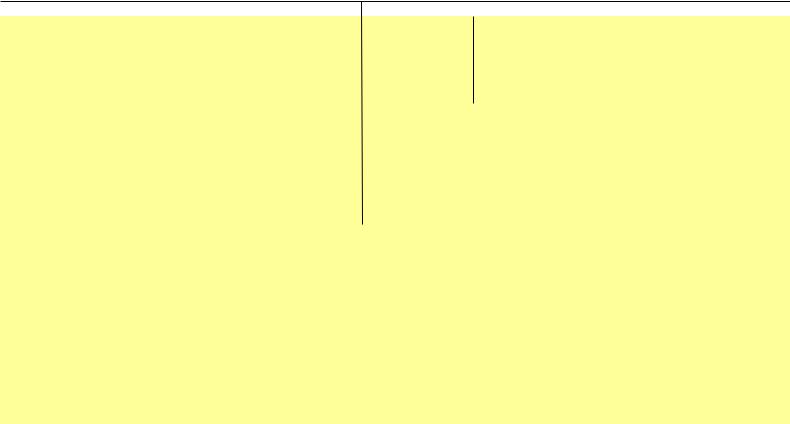
Seats / 3-2
Seat belts / 3-15
Child restraint system / 3-26
Air bag — supplemental restraint system / 3-38
Safety features of your vehicle |
3 |
|||
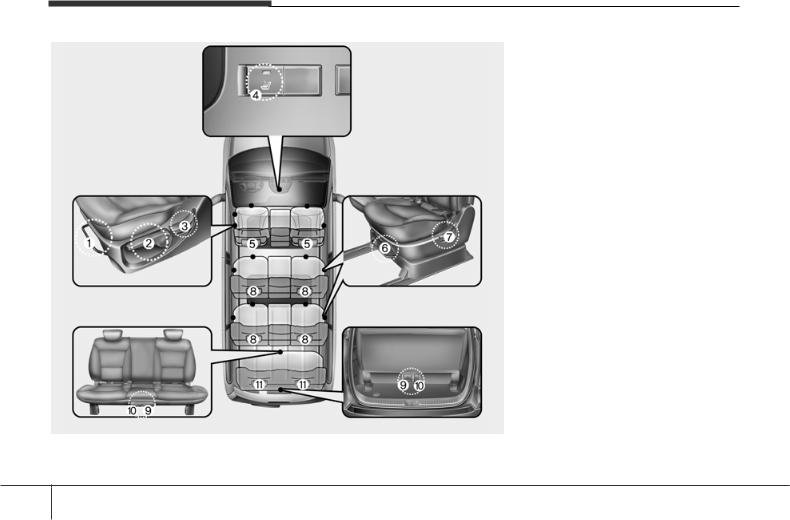
Safety features of your vehicle
SEATS
Front seat
(1) Forward and backward
(2) Seatback angle
(3) Seat cushion height (Driver’s seat)*
(4) Seat warmer (Driver’s seat)*
(5) Headrest
2nd row seat* / 3rd row seat*
(6) Forward and backward/
Seat rotation (2nd row seat only)*
(7) Seatback angle
(8) Headrest
4th row seat*
(9) Forward and backward
(10) Seat cushion folding
(11) Headrest
*: if equipped
OTQ037001E
C010000BTQ
The actual seats in the vehicle may differ from the illustration.
3 2
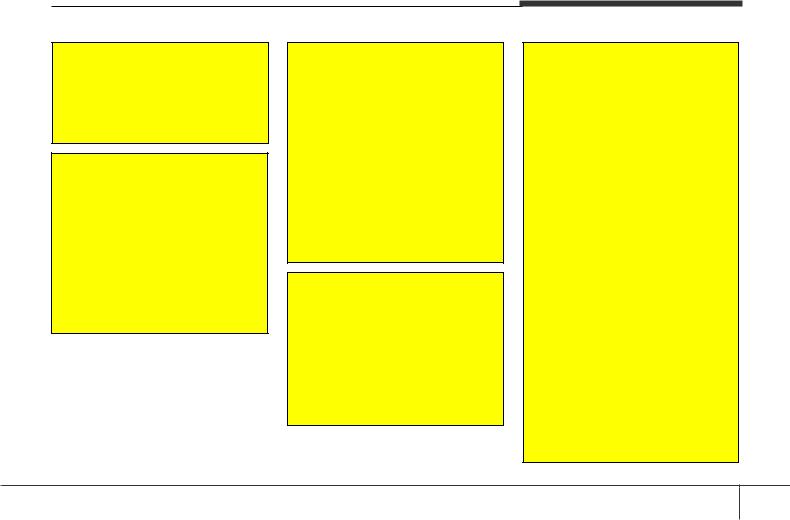

Loose objects in the driver’s foot area could interfere with the operation of the foot pedals, possibly causing an accident. Do not place anything under the front seats.

When you return the seatback to its upright position, hold the seatback and return it slowly and be sure there are no other occupants around the seat. If the seatback is returned without being held and controlled, the back of the seat could spring forward resulting in accidental injury to a person struck by the seatback.

Riding in a vehicle with the seatback reclined could lead to serious or fatal injury in an accident. If a seat is reclined during an accident, the occupant’s hips may slide under the lap portion of the seat belt applying great force to the unprotected abdomen. Serious or fatal internal injuries could result. The driver must advise the front passenger to keep the seatback in an upright position whenever the vehicle is in motion.

Do not use a sitting cushion that reduces friction between the seat and passenger. The passenger’s hips may slide under the lap portion of the seat belt during an accident or a sudden stop. Serious or fatal internal injuries could result because the seat belt can’t operate normally.
Safety features of your vehicle

•Never attempt to adjust the seat while the vehicle is moving. This could result in loss of control, and an accident causing death, serious injury, or property damage.
•Do not allow anything to interfere with the normal position of the seatback. Storing items against a seatback or in any other way interfering with proper locking of a seatback could result in serious or fatal injury in a sudden stop or collision.
•Always drive and ride with your seatback upright and the lap portion of the seat belt snug and low across the hips. This is the best position to protect you in case of an accident.
•In order to avoid unnecessary and perhaps severe air bag injuries, always sit as far back as possible from the steering wheel while maintaining comfortable control of the vehicle. We recommend that your chest be at least 250 mm (10 inches) away from the steering wheel.
3 3
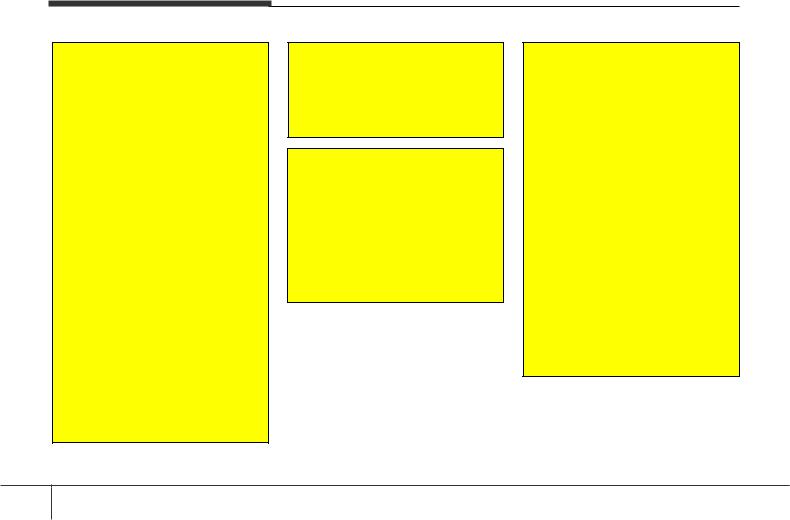
Safety features of your vehicle

•The rear seatback must be securely latched. If not, passengers and objects could be thrown forward resulting in serious injury or death in the event of a sudden stop or collision.
•Luggage and other cargo should be laid flat in the cargo area. If objects are large, heavy, or must be piled, they must be secured. Under no circumstances should cargo be piled higher than the seatbacks. Failure to follow these warnings could result in serious injury or death in the event of a sudden stop, collision or rollover.
•No passenger should ride in the cargo area or sit or lie on folded seatbacks while the vehicle is moving. All passengers must be properly seated in seats and restrained properly while riding.
•When resetting the seatback to the upright position, make sure it is securely latched by pushing it forward and backwards.
(Continued)
(Continued)
•To avoid the possibility of burns, do not remove the carpet in the cargo area. Emission control devices beneath this floor generate high temperatures.

After adjusting the seat, always check that it is securely locked into place by attempting to move the seat forward or backward without using the lock release lever. Sudden or unexpected movement of the driver’s seat could cause you to lose control of the vehicle resulting in an accident.

•Do not adjust the seat while wearing seat belts. Moving the seat cushion forward may cause strong pressure on the abdomen.
•Use extreme caution so that hands or other objects are not caught in the seat mechanisms while the seat is moving.
•Do not put a cigarette lighter on the floor or seat. When you operate the seat, gas may gush out of the lighter and cause fire.
•If there are occupants in the rear seats, be careful while adjusting the front seat position.
•Use extreme caution when picking small objects trapped under the seats or between the seat and the center console. Your hands might be cut or injured by the sharp edges of the seat mechanism.
3 4
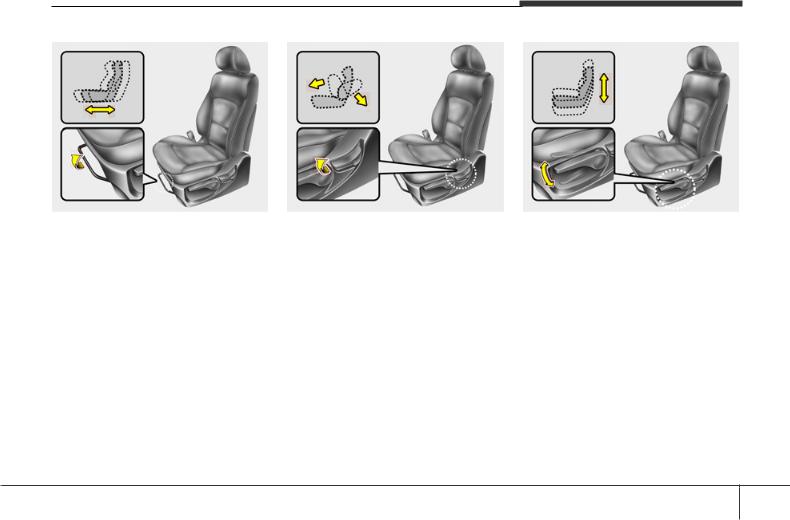
Safety features of your vehicle
OTQ037002
Front seat adjustment
C010101AUN
Forward and backward
To move the seat forward or backward:
1.Pull the seat slide adjustment lever under the front edge of the seat cushion up and hold it.
2.Slide the seat to the position you desire.
3.Release the lever and make sure the seat is locked in place.
Adjust the seat before driving, and make sure the seat is locked securely by trying to move forward and backward without using the lever. If the seat moves, it is not locked properly.
OTQ037003
C010102AUN
Seatback angle
To recline the seatback:
1.Lean forward slightly and lift up on the seatback recline lever located on the outside of the seat at the rear.
2.Carefully lean back on the seat and adjust the seatback of the seat to the position you desire.
3.Release the lever and make sure the seatback is locked in place. (The lever MUST return to its original position for the seatback to lock.)
OTQ037004
C010103AUN
Seat cushion height (for driver’s seat)
To change the height of the seat cushion, push the lever that is located on the outside of the seat cushion upwards or downwards.
•To lower the seat cushion, push the lever down several times.
•To raise the seat cushion, pull the lever up several times.
3 5
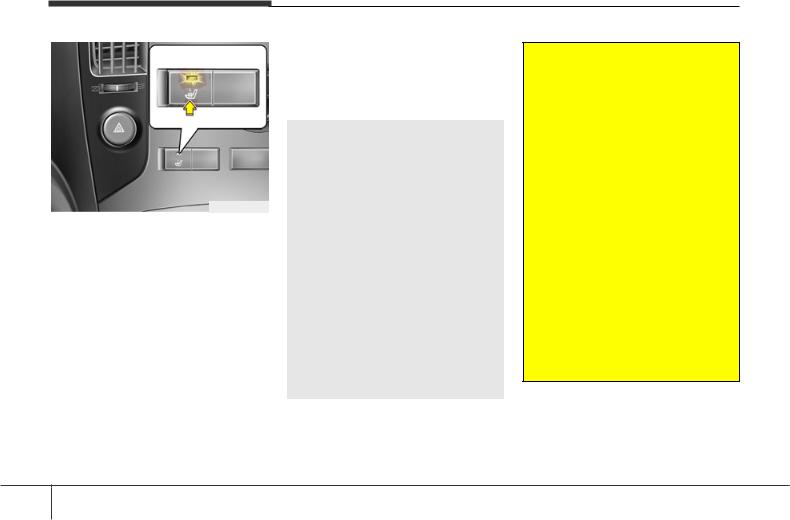
Safety features of your vehicle
OTQ037008E
C010107CTQ
Seat warmer
(Driver’s seat, if equipped)
The seat warmer is provided to warm the driver’s seat during cold weather. With the ignition switch in the ON position, push the switch to warm the driver’s seat. During mild weather or under conditions where the operation of the seat warmer is not needed, keep the switch in the «OFF» position.
•The seat warmer defaults to the OFF position whenever the ignition switch is turned on.
NOTICE
With the seat warmer switch in ON position, the heating system in the seat turns off or on automatically depending on the seat temperature.

•When cleaning the seats, do not use an organic solvent such as thinner, benzene, alcohol and gasoline. Doing so may damage the surface of the heater or seats.
•To prevent overheating the seat warmer, do not place anything on the seats that insulates against heat, such as blankets, cushions or seat covers while the seat warmer is in operation.
•Do not place heavy or sharp objects on seats equipped with seat warmer. Damage to the seat warming components could occur.
•Do not change the seat cover. It may damage the seat warmer or airventilation system.

Passengers should use extreme caution when using seat warmers due to the possibility of excess heating or burns. The seat warmer may cause burns even at low temperatures, especially if used for long periods of time.
In particular, the driver must exercise extreme care for the following types of passengers:
1.Infants, children, elderly or handicapped persons, or hospital outpatients
2.Persons with sensitive skin or those that burn easily
3.Fatigued individuals
4.Intoxicated individuals
5.Individuals taking medication that can cause drowsiness or sleepiness (sleeping pills, cold tablets, etc.)
3 6
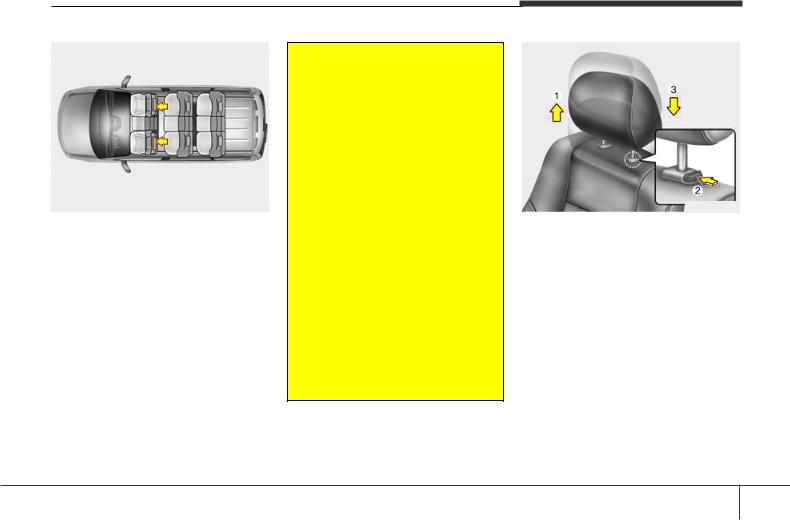
Safety features of your vehicle
OTQC031161E
C010104CTQ
Headrest
The driver’s and front passenger’s seats are equipped with a headrest for the occupant’s safety and comfort.
The headrest not only provides comfort for the driver and front passenger, but also helps to protect the head and neck in the event of a collision.

•For maximum effectiveness in case of an accident, the headrest should be adjusted so the middle of the headrest is at the same height of the center of gravity of an occupant’s head. Generally, the center of gravity of most people’s head is similar with the height of the top of their eyes. Also, adjust the headrest as close to your head as possible. For this reason, the use of a cushion that holds the body away from the seatback is not recommended.
•Do not operate the vehicle with the headrests removed as severe injury to the occupants may occur in the event of an accident. Headrests may provide protection against neck injuries when properly adjusted.
•Do not adjust the headrest position of the driver’s seat while the vehicle is in motion.
OFD037037
Adjusting the height up and down
To raise the headrest, pull it up to the desired position (1). To lower the headrest, push and hold the release button (2) on the headrest support and lower the headrest to the desired position (3).
3 7
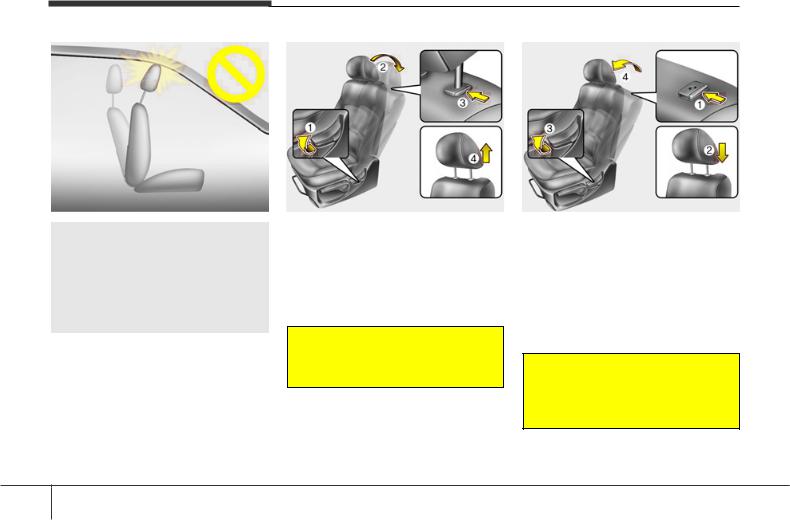
Safety features of your vehicle
OYFH034205

If you recline the seatback towards the front with the head restraint and seat cushion raised, the head restraint may come in contact with the sunvisor or other parts of the vehicle.
OTQ033200
Removal
To remove the headrest:
1.Recline the seatback (2) with the recline lever (1).
2.Raise headrest as far as it can go.
3.Press the headrest release button (3) while pulling the headrest up (4).

NEVER allow anyone to ride in a seat with the headrest removed.
OTQ033201
Reinstall
To reinstall the headrest :
1.Put the headrest poles (2) into the holes while pressing the release button
(1).
2.Recline the seatback (4) with the recline lever (3).
3.Adjust the headrest to the appropriate height.

Always make sure the headrest locks into position after reinstalling and adjusting it properly.
3 8
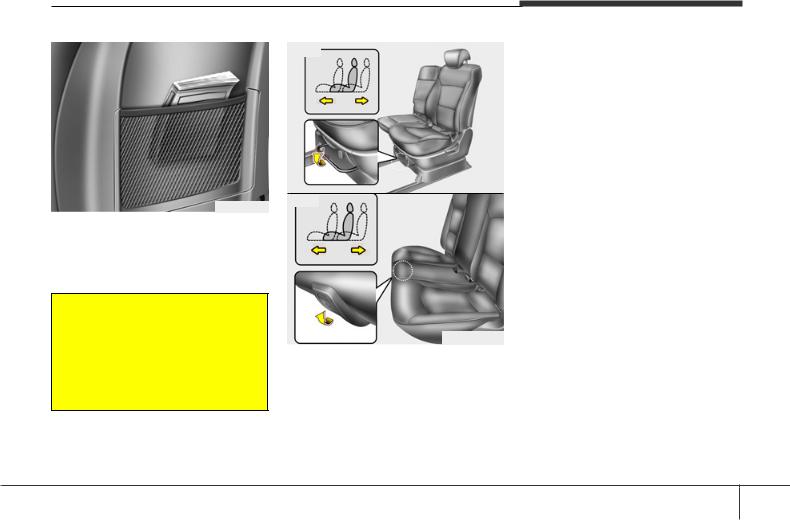
Safety features of your vehicle
OTQ037036
C010108AUN
Seatback pocket (if equipped)
The seatback pocket is provided on the back of the front passenger’s and driver’s seatbacks.

Do not put heavy or sharp objects in the seatback pockets. In an accident they could come loose from the pocket and injure vehicle occupants.
Type A
OTQ037011
Type B
OTQ037011G
Rear seat adjustment
C010301ATQ
Forward and backward (2nd and 3rd row, if equipped)
To move the seat forward or backward:
1.Pull up the seat slide adjustment lever under the front edge of the seat cushion and hold it.
2.Slide the seat to the position you desire.
3.Release the lever and make sure the seat is locked in place.
Adjust the seat before driving, and make sure the seat is locked securely by trying to move forward and backward without using the lever. If the seat moves, it is not locked properly.
3 9
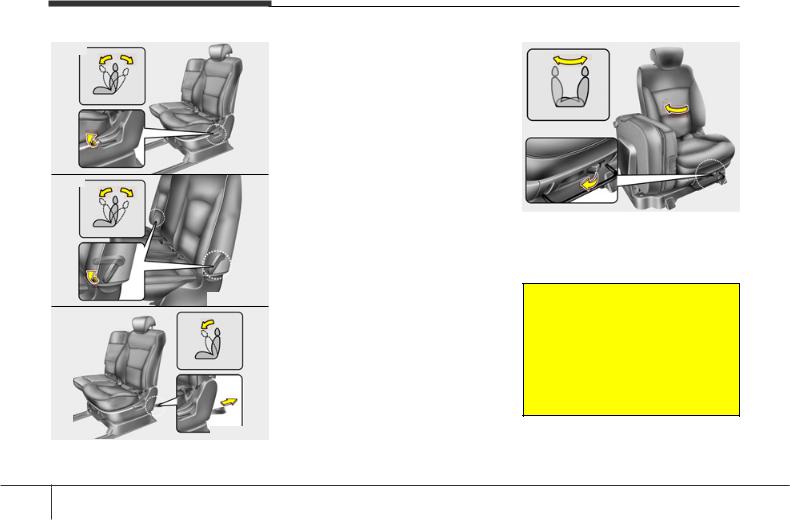
Safety features of your vehicle
Type A
OTQ037012
Type B
OTQ037012G
Type C
OTQ037015
C010302ATQ
Seatback angle (if equipped)
To recline the seatback:
1.Pull or pull up the seatback recline lever.
2.Carefully lean back the seat and adjust the seatback to the position you desire.
3.Release the lever and make sure the seatback is locked in place. (The lever MUST return to its original position for the seatback to lock.)
OTQ037033
Seat rotation
(2nd row seat, if equipped)
Pull the lever and rotate the seat clockwise.

• Never rotate the seat while the vehicle is in motion.
• When the seat is rotated, be sure that the seat is securely locked in position. It not, it may result in serious injury in the event of a sudden stop.
3 10
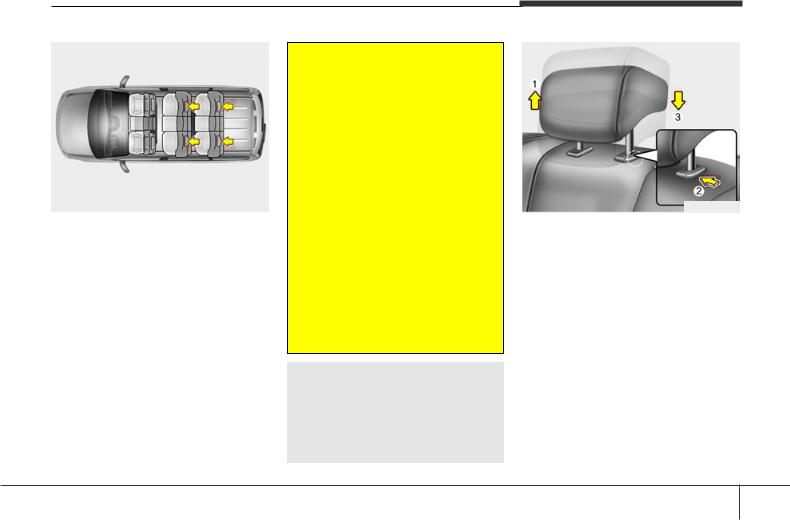
Safety features of your vehicle
OTQC031161F
C010303CTQ
Headrest
The rear seats are equipped with headrests in the outboard seating positions (except center seating position) for the occupant’s safety and comfort.
The headrest not only provides comfort for passengers, but also helps to protect the head and neck in the event of a collision.

•For maximum effectiveness in case of an accident, the headrest should be adjusted so the middle of the headrest is at the same height of the center of gravity of an occupant’s head. Generally, the center of gravity of most people’s head is similar with the height of the top of their eyes. Also, adjust the headrest as close to your head as possible. The use of a cushion that holds the body away from the seatback is not recommended.
•Do not operate the vehicle with the headrests removed as severe injury to an occupant may occur in the event of an accident. Headrests may provide protection against severe neck injuries when properly adjusted.

When there is no occupant in the rear seats, adjust the height of the headrest to the lowest position. The rear seat headrest can reduce the visibility of the rear area.
OHM038017
Adjusting the height up and down
To raise the headrest, pull it up to the desired position (1). To lower the headrest, push and hold the release button (2) on the headrest support and lower the headrest to the desired position (3).
3 11
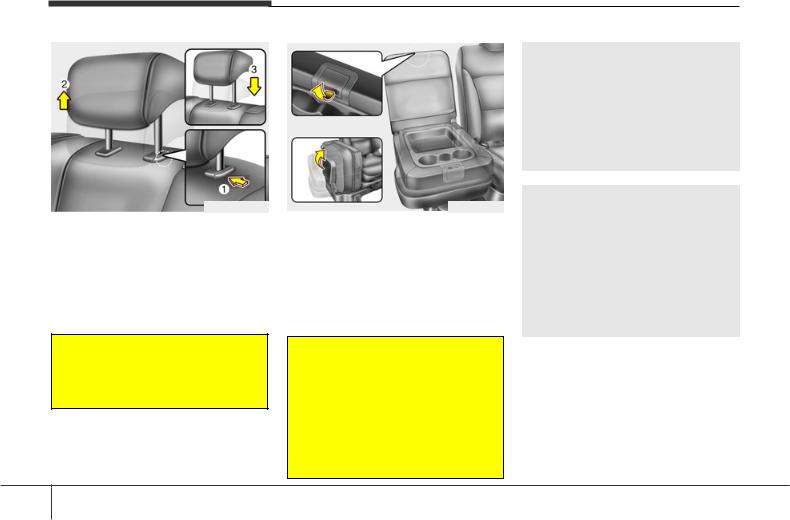
Safety features of your vehicle
OHM038018N
Removal
To remove the headrest, raise it as far as it can go then press the release button
(1) while pulling upward (2).
To reinstall the headrest, put the headrest poles (3) into the holes while pressing the release button (1). Then adjust it to the appropriate height.

Make sure the headrest locks in position after adjusting it to properly protect the occupants.
OTQ037031
C010304ATQ
Center seat folding (if equipped)
1.Stow the rear seat belt in the pocket to prevent the seat belt from being damaged.
2.Pull the release knob and fold the seatback forward.
3.Fold up the seat.

When you return the seatback to its upright position, hold the seatback and return it slowly. If the seatback is returned without holding it, the back of the seat could spring forward resulting in injury caused by being struck by the seatback.
CAUTION — Damaging rear seat belt buckles
When you fold the rear (2nd and/or 3rd row) seatback, insert the buckle in the pocket between the rear seatback and cushion. Doing so can prevent the buckle from being damaged by the rear seatback.
CAUTION — Rear seat belts
When returning the rear (2nd and/or 3rd row) seatbacks to the upright position, remember to return the rear shoulder belts to their proper position. Routing the seat belt webbing through the rear seat belt guides will help keep the belts from being trapped behind or under the seats.
3 12
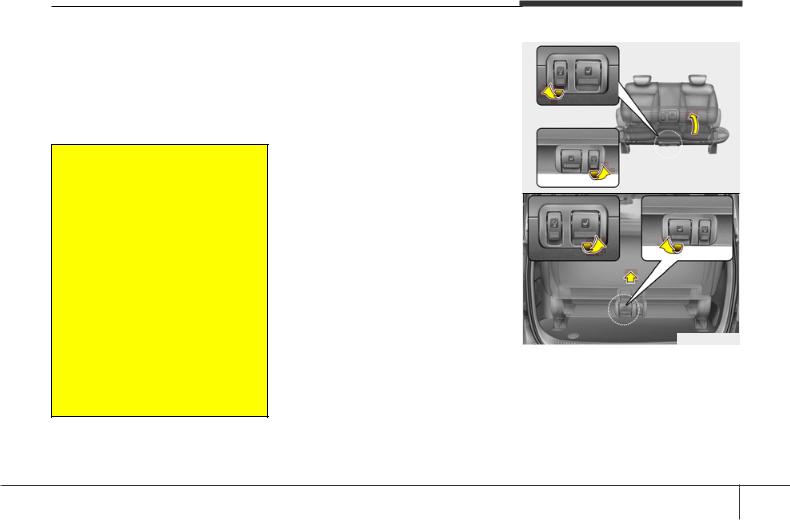
Safety features of your vehicle
C010307ATQ
Folding the rear seat
(4th row seat, if equipped)
The rear seat cushion may be folded to facilitate carrying long items or to increase the luggage capacity of the vehicle.

The purpose of the fold rear seat is to allow you to carry longer objects that could not be accommodated in the cargo area.
Never allow passengers to sit on a improper position (ex : top of the folded seat, floor etc.) while the car is moving as this is not a proper seating position and no seat belts are available for use. This could result in serious injury or death in case of an accident or sudden stop. Objects carried on the cargo area should not extend higher than the top of the front seatbacks. Doing this could allow cargo to slide forward and cause injury or damage during sudden stops.
To fold the rear seat:
1.Stow the rear seat belt in the pocket to prevent the seat belt from being damaged.
2.Set the 3rd row seatback to the upright position and if necessary, slide the 3rd row seat forward.
OTQ037016
OTQ037017
3. Pull on the seatcushion folding lever, then fold the seat toward the rear of the vehicle.
4. Increase the luggauge compartment space by moving the rear seat using the sliding lever.
3 13

Safety features of your vehicle

When you return the rear seat cushion to its locking position after being folded:
Be careful not to damage the seat belt webbing or buckle. Do not allow the seat belt webbing or buckle to get caught or pinched in the rear seat. Ensure that the seat is completely locked into its proper position by pushing the seat cushion and seatback.
Otherwise, in an accident or sudden stop, the seat could fold, which could result in serious injury or death.
OUN026140

The headrest on the seat (especially the last row seat) should be adjusted so the middle of the headrest is at the same height as the top of the occupant’s eyes.
If the tailgate is pushed down to close when a passenger’s head is not against a properly adjusted headrest or a tall person is seated, the tailgate may hit the occupant’s head, which could cause injury.

Cargo should always be secured to prevent it from being thrown about the vehicle in a collision and causing injury to the vehicle occupants. Do not place objects in the rear seats, since they cannot be properly secured and may hit the front seat occupants in a collision.

Make sure the engine is off, the automatic transmission is in P (Park) or the manual transmission is in R (Reverse) or 1st, and the parking brake is securely applied whenever loading or unloading cargo. Failure to take these steps may allow the vehicle to move if the shift lever is inadvertently moved to another position.
3 14

SEAT BELTS
C020100CUN
Seat belt restraint system

•For maximum restraint system protection, the seat belts must always be used whenever the car is moving.
•Seat belts are most effective when seatbacks are in the upright position.
•Children age 12 and under must always be properly restrained in the rear seat. Never allow children to ride in the front passenger seat. If a child over 12 must be seated in the front seat, he/she must be properly belted and the seat should be moved as far back as possible.
•Never wear the shoulder belt under your arm or behind your back. An improperly positioned shoulder belt can cause serious injuries in a crash. The shoulder belt should be positioned midway over your shoulder across your collarbone.
(Continued)
(Continued)
•Never wear a seat belt over fragile objects. If there is a sudden stop or impact, the seat belt can damage it.
•Avoid wearing twisted seat belts. A twisted belt can’t do its job as well. In a collision, it could even cut into you. Be sure the belt webbing is straight and not twisted.
•Be careful not to damage the belt webbing or hardware. If the belt webbing or hardware is damaged, replace it.
Safety features of your vehicle

Seat belts are designed to bear upon the bony structure of the body, and should be worn low across the front of the pelvis, or the pelvis, chest and shoulders, as applicable; wearing the lap section of the belt across the abdominal area must be avoided.
Seat belts should be adjusted as firmly as possible, consistent with comfort, to provide the protection for which they have been designed. A slack belt will greatly reduce the protection afforded to the occupant.
Care should be taken to avoid contamination of the webbing with polishes, oils and chemicals and particularly battery acid. Cleaning may safely be carried out using mild soap and water. The belt should be replaced if webbing becomes frayed, contaminated or damaged.
(Continued)
3 15

Safety features of your vehicle
(Continued)
It is essential to replace the entire assembly after it has been worn in a severe impact even if damage to the assembly is not obvious. Belts should not be worn with straps twisted. Each seat belt assembly must only be used by one occupant; it is dangerous to put a belt around a child being carried on the occupant’s lap.

•No modifications or additions should be made by the user which will either prevent the seat belt adjusting devices from operating to remove slack, or prevent the seat belt assembly from being adjusted to remove slack.
•When you fasten the seat belt, be careful not to latch the seat belt in buckles of other seat. It’s very dangerous and you may not be protected by the seat belt properly.
•Do not unfasten the seat belt and do not fasten and unfasten the seat belt repeatedly while driving. This could result in loss of control, and an accident causing death, serious injury, or property damage.
•When fastening the seat belt, make sure that the seat belt does not pass over objects that are hard or can break easily.
•Make sure there is nothing in the buckle. The seat belt may not be fastened securely.
1GQA2083
D150302AEN-EE
Seat belt warning (if equipped)
As a reminder to the driver, the seat belt warning light will blink for approximately 6 seconds each time you turn the ignition switch ON regardless of belt fastening.
If the driver’s seat belt is unfastened after the ignition switch is ON, the seat belt warning light blinks again for approximately 6 seconds.
Seat belt warning chime (if equipped)
If the driver’s seat belt is not fastened when the ignition switch is turned ON or if it is unfastened after the ignition switch is ON, the seat belt warning chime will sound for approximately 6 seconds. At this time, if the seat belt is fastened, the chime will stop at once.
3 16

Safety features of your vehicle
NOTICE
If you are not able to pull out the seat belt from the retractor, firmly pull the belt out and release it. Then you will be able to pull the belt out smoothly.
B180A01NF-1
C020102AEN
Lap/shoulder belt
To fasten your seat belt:
To fasten your seat belt, pull it out of the retractor and insert the metal tab (1) into the buckle (2). There will be an audible «click» when the tab locks into the buckle. The seat belt automatically adjusts to the proper length only after the lap belt portion is adjusted manually so that it fits snugly around your hips. If you lean forward in a slow, easy motion, the belt will extend and let you move around. If there is a sudden stop or impact, however, the belt will lock into position. It will also lock if you try to lean forward too quickly.
B200A02NF

You should place the lap belt portion as low as possible and snugly across your hips, not on your waist. If the lap belt is located too high on your waist, it may increase the chance of injury in the event of a collision. Both arms should not be under or over the belt. Rather, one should be over and the other under, as shown in the illustration.
Never wear the seat belt under the arm nearest the door.
3 17

Safety features of your vehicle
Front seat
OEN036029
Height adjustment (if equipped)
You can adjust the height of the shoulder belt anchor to one of 5 positions for maximum comfort and safety.
The height of the adjusting seat belt should not be too near your neck. The shoulder portion should be adjusted so that it lies across your chest and midway over your shoulder nearest the door and not your neck.
To adjust the height of the seat belt anchor, lower or raise the height adjuster into an appropriate position.
To raise the height adjuster, pull it up (1). To lower it, push it down (3) while pressing the height adjuster button (2).
Release the button to lock the anchor into position. Try sliding the height adjuster to make sure that it has locked into position.

•Verify the shoulder belt anchor is locked into position at the appropriate height. Never position the shoulder belt across your neck or face. Improperly positioned seat belts can cause serious injuries in an accident.
•Failure to replace seat belts after an accident could leave you with damaged seat belts that will not provide protection in the event of another collision leading to personal injury or death. Replace your seat belts after being in an accident as soon as possible.
B210A01NF-1
To release the seat belt:
The seat belt is released by pressing the release button (1) in the locking buckle. When it is released, the belt should automatically draw back into the retractor.
If this does not happen, check the belt to be sure it is not twisted, then try again.
3 18

Safety features of your vehicle
B220A04NF-1
C020103AUN
Lap belt (if equipped)
To fasten your seat belt:
To fasten a 2-point static type belt, insert the metal tab (1) into the locking buckle
(2). There will be an audible «click» when the tab locks into the buckle. Check to make sure the belt is properly locked and that the belt is not twisted.
OHM039105N
Too high
B220B01NF
With a 2-point static type seat belt, the length must be adjusted manually so it fits snugly around your body. Fasten the belt and pull on the loose end to tighten. The belt should be placed as low as possible on your hips, not on your waist. If the belt is too high, it could increase the possibility of your being injured in an accident.
OTQ037020
When using the rear center seat belt, the buckle with the “CENTER” mark must be used.
3 19

Safety features of your vehicle
Type A
Type B
B210A02NF-1
To release the seat belt:
When you want to release the seat belt, press the button (1) in the locking buckle.

The center lap belt latching mecha-
nism is different from those for the Type C rear seat shoulder belts. When fas-
tening the rear seat shoulder belts or the center lap belt, make sure they are inserted into the correct buckles to obtain maximum protection from the seat belt system and assure proper operation.
C020105AUN
Stowing the rear seat belt
•The rear seat belt buckles can be stowed in the pocket between the rear seatback and cushion when not in use.
•The center seat belt can be stowed with the plate and webbing rolled in the pocket between the rear seatback and cushion.
OTQ037021
OTQ037022
OTQ037022G
3 20

Safety features of your vehicle
OED030300
C020200CEN
Pre-tensioner seat belt (if equipped)
Your vehicle is equipped with driver’s and front passenger’s pre-tensioner seat belts. The purpose of the pre-tensioner is to make sure that the seat belts fit tightly against the occupant’s body in certain frontal collisions. The pre-tensioner seat belts may be activated in crashes where the frontal collision is severe enough.
When the vehicle stops suddenly, or if the occupant tries to lean forward too quickly, the seat belt retractor will lock into position. In certain frontal collisions, the pre-tensioner will activate and pull the seat belt into tighter contact against the occupant’s body.

For your safety, be sure that the belt webbing is not loose or twisted and always sit properly on your seat.
1KMB3311A
The seat belt pre-tensioner system consists mainly of the following components. Their locations are shown in the illustration:
1.SRS air bag warning light
2.Retractor pre-tensioner assembly
3.SRS control module
3 21

Safety features of your vehicle

To obtain maximum benefit from a pre-tensioner seat belt:
1.The seat belt must be worn correctly and adjusted to the proper position. Please read and follow all of the important information and precautions about your vehicle’s occupant safety features – including seat belts and air bags – that are provided in this manual.
2.Be sure you and your passengers always wear seat belts properly.
NOTICE
•Both the driver’s and front passenger’s pre-tensioner seat belts may be activated in certain frontal collisions.
•When the pre-tensioner seat belts are activated, a loud noise may be heard and fine dust, which may appear to be smoke, may be visible in the passenger compartment. These are normal operating conditions and are not hazardous.
•Although it is harmless, the fine dust may cause skin irritation and should not be breathed for prolonged periods. Wash all exposed skin areas thoroughly after an accident in which the pretensioner seat belts were activated.
NOTICE
Because the sensor that activates the SRS air bag is connected with the pretensioner seat belt, the SRS air bag warning light 

If the pre-tensioner seat belt is not working properly, this warning light will illuminate even if there is no malfunction of the SRS air bag.
If the SRS air bag warning light does not illuminate when the ignition switch is turned to ON, or if it remains illuminated after illuminating for approximately 6 seconds, or if it illuminates while the vehicle is being driven, we recommend that the system be inspected by an authorized HYUNDAI dealer.

•Pre-tensioners are designed to operate only one time. After activation, pre-tensioner seat belts must be replaced. All seat belts, of any type, should always be replaced after they have been worn during a collision.
•The pre-tensioner seat belt assembly mechanisms become hot during activation. Do not touch the pre-tensioner seat belt assemblies for several minutes after they have been activated.
•Do not attempt to inspect or replace the pre-tensioner seat belts yourself. We recommend that the system be inspected by an authorized HYUNDAI dealer.
•Do not strike the pre-tensioner seat belt assemblies.
•Do not attempt to service or repair the pre-tensioner seat belt system in any manner.
(Continued)
3 22

(Continued)
•Improper handling of the pre-ten- sioner seat belt assemblies, and failure to heed the warnings not to strike, modify, inspect, replace, service or repair the pre-tension- er seat belt assemblies may lead to improper operation or inadvertent activation and serious injury.
•Always wear the seat belts when driving or riding in a motor vehicle.
•If the vehicle or pre-tensioner seat belt must be discarded, we recommend that you contact an authorized HYUNDAI dealer.

Body work on the front area of the vehicle may damage the pre-ten- sioner seat belt system. Therefore, we recommend that the system be serviced by an authorized HYUNDAI dealer.
C020300AUN
Seat belt precautions

All occupants of the vehicle must wear their seat belts at all times. Seat belts and child restraints reduce the risk of serious or fatal injuries for all occupants in the event of a collision or sudden stop. Without a seat belt, occupants could be shifted too close to a deploying air bag, strike the interior structure or be thrown from the vehicle. Properly worn seat belts greatly reduce these hazards.
Always follow the precautions about seat belts, air bags and occupant seating contained in this manual.
Safety features of your vehicle
C020306AUN
Infant or small child
You should be aware of the specific requirements in your country. Child and/or infant seats must be properly placed and installed in the rear seat. For more information about the use of these restraints, refer to “Child restraint system” in this section.

Every person in your vehicle needs to be properly restrained at all times, including infants and children. Never hold a child in your arms or lap when riding in a vehicle. The violent forces created during a crash will tear the child from your arms and throw the child against the interior. Always use a child restraint appropriate for your child’s height and weight.
3 23

Safety features of your vehicle
NOTICE
Small children are best protected from injury in an accident when properly restrained in the rear seat by a child restraint system that meets the requirements of the Safety Standards of your country. Before buying any child restraint system, make sure that it has a label certifying that it meets Safety Standards of your country. The restraint must be appropriate for your child’s height and weight. Check the label on the child restraint for this information. Refer to “Child restraint system” in this section.
C020301AUN
Larger children
Children who are too large for child restraint systems should always occupy the rear seat and use the available lap/shoulder belts. The lap portion should be fastened snug on the hips and as low as possible. Check belt fit periodically. A child’s squirming could put the belt out of position. Children are afforded the most safety in the event of an accident when they are restrained by a proper restraint system in the rear seat.
If a larger child (over age 12) must be seated in the front seat, the child should be securely restrained by the available lap/shoulder belt and the seat should be placed in the rearmost position.
Children age 12 and under should be restrained securely in the rear seat. NEVER place a child age 12 and under in the front seat. NEVER place a rear facing child seat in the front seat of a vehicle.
If the shoulder belt portion slightly touches the child’s neck or face, try placing the child closer to the center of the vehicle. If the shoulder belt still touches their face or neck they need to be returned to a child restraint system.

•Never allow a shoulder belt to be in contact with a child’s neck or face while the vehicle is in motion.
•If seat belts are not properly worn and adjusted on children, there is a risk of death or serious injury.
C020302AUN
Pregnant women
The use of a seat belt is recommended for pregnant women to lessen the chance of injury in an accident. When a seat belt is used, the lap belt portion should be placed as low and snugly as possible on the hips, not across the abdomen. For specific recommendations, consult a physician.
C020303AUN
Injured person
A seat belt should be used when an injured person is being transported. When this is necessary, you should consult a physician for recommendations.
C020304AUN
One person per belt
Two people (including children) should never attempt to use a single seat belt. This could increase the severity of injuries in case of an accident.
3 24

Safety features of your vehicle
C020305AUN
Do not lie down
To reduce the chance of injuries in the event of an accident and to achieve maximum effectiveness of the restraint system, all passengers should be sitting up and the front and rear seats should be in an upright position when the car is moving. A seat belt cannot provide proper protection if the person is lying down in the rear seat or if the front and rear seats are in a reclined position.

Riding with a reclined seatback increases your chance of serious or fatal injuries in the event of a collision or sudden stop. The protection of your restraint system (seat belts and air bags) is greatly reduced by reclining your seat. Seat belts must be snug against your hips and chest to work properly. The more the seatback is reclined, the greater the chance that an occupant’s hips will slide under the lap belt causing serious internal injuries or the occupant’s neck could strike the shoulder belt. Drivers and passengers should always sit well back in their seats, properly belted, and with the seatbacks upright.
C020400AEN
Care of seat belts
Seat belt systems should never be disassembled or modified. In addition, care should be taken to assure that seat belts and belt hardware are not damaged by seat hinges, doors or other abuse.

When you return the rear seat to its seating position after the rear seat has been folded, be careful not to damage the seat belt webbing or buckle. Be sure that the webbing or buckle does not get caught or pinched in the rear seat. A seat belt with damaged webbing or buckle could possibly fail during a collision or sudden stop, resulting in serious injury. If the webbing or buckles are damaged, get them replaced immediately.
C020401AEN
Periodic inspection
All seat belts should be inspected periodically for wear or damage of any kind. Any damaged parts should be replaced as soon as possible.
C020402AUN
Keep belts clean and dry
Seat belts should be kept clean and dry. If belts become dirty, they can be cleaned by using a mild soap solution and warm water. Bleach, dye, strong detergents or abrasives should not be used because they may damage and weaken the fabric.
C020403AEN
When to replace seat belts
Entire in-use seat belt assembly or assemblies should be replaced if the vehicle has been involved in an accident. This should be done even if no damage is visible. If you have additional questions regarding seat belt operation, we recommend that you consult an authorized HYUNDAI dealer.
3 25

Safety features of your vehicle
CHILD RESTRAINT SYSTEM
C030000AEN
Children riding in the car should sit in the rear seat and must always be properly restrained to minimize the risk of injury in an accident, sudden stop or sudden maneuver. According to accident statistics, children are safer when properly restrained in the rear seats than in the front seat. Larger children not in a child restraint should use one of the seat belts provided.
You should be aware of the specific requirements in your country. Child and/or infant safety seats must be properly placed and installed in the rear seat. You must use a commercially available child restraint system that meets the requirements of the Safety Standards of your country. Child restraint systems are designed to be secured in vehicle seats by lap belts or the lap belt portion of a lap/shoulder belt, or by a tether anchor and/or ISOFIX anchors (if equipped).
Children could be injured or killed in a crash if their restraints are not properly secured. For small children and babies, a child seat or infant seat must be used. Before buying a particular child restraint system, make sure it fits your car seat and seat belts, and fits your child.
Follow all the instructions provided by the manufacturer when installing the child restraint system.

•A child restraint system must be placed in the rear seat. Never install a child or infant seat on the front passenger’s seat. Should an accident occur and cause the passenger-side air bag to deploy, it could severely injure or kill an infant or child seated in an infant or child seat. Thus only use a child restraint in the rear seat of your vehicle.
•A seat belt or child restraint system can become very hot if it is left in a closed vehicle on a sunny day, even if the outside temperature does not feel hot. Be sure to check the seat cover and buckles before placing a child there.
(Continued)
(Continued)
•When the child restraint system is not in use, store it in the luggage area or fasten it with a seat belt so that it will not be thrown forward in the case of a sudden stop or an accident.
•Children may be seriously injured or killed by an inflating air bag. All children, even those too large for child restraints, must ride in the rear seat.
3 26


To reduce the chance of serious or fatal injuries:
•Children of all ages are safer when restrained in the rear seat. A child riding in the front passenger seat can be forcefully struck by an inflating air bag resulting in serious or fatal injuries.
•Always follow the child restraint system manufacturer’s instructions for installation and use of the child restraint.
•Always make sure the child seat is secured properly in the car and your child is securely restrained in the child seat.
•Never hold a child in your arms or lap when riding in a vehicle. The violent forces created during a crash will tear the child from your arms and throw the child against the car’s interior.
•Never put a seat belt over yourself and a child. During a crash, the belt could press deep into the child causing serious internal injuries.
(Continued)
(Continued)
•Never leave children unattended in a vehicle – not even for a short time. The car can heat up very quickly, resulting in serious injuries to children inside. Even very young children may inadvertently cause the vehicle to move, entangle themselves in the windows, or lock themselves or others inside the vehicle.
•Never allow two children, or any two persons, to use the same seat belt.
•Children often squirm and reposition themselves improperly. Never let a child ride with the shoulder belt under their arm or behind their back. Always properly position and secure children in the rear seat.
•Never allow a child to stand-up or kneel on the seat or floor of a moving vehicle. During a collision or sudden stop, the child can be violently thrown against the vehicle’s interior, resulting in serious injury.
(Continued)
Safety features of your vehicle
(Continued)
•Never use an infant carrier or a child safety seat that «hooks» over a seatback, it may not provide adequate security in an accident.
•Seat belts can become very hot, especially when the car is parked in direct sunlight. Always check seat belt buckles before fastening them over a child.
•After an accident, we recommend that the system be checked by an authorized HYUNDAI dealer.
3 27

Safety features of your vehicle
Rearward-facing child restraint system
CRS09
Forward-facing child restraint system
OTQ037038
C030100AEN
Using a child restraint system
For small children and babies, the use of a child seat or infant seat is required. This child seat or infant seat should be of appropriate size for the child and should be installed in accordance with the manufacturer’s instructions.
For safety reasons, we recommend that the child restraint system be used in the rear seats.

Never place a rear-facing child restraint in the front passenger seat, because of the danger that an inflating passenger-side air bag could impact the rear-facing child restraint and kill the child.

•A child can be seriously injured or killed in a collision if the child restraint is not properly anchored to the car and the child is not properly restrained in the child restraint. Before installing the child restraint system, read the instructions supplied by the child restraint system manufacturer.
•If the seat belt does not operate as described in this section, we recommend that the system be checked by an authorized HYUNDAI dealer.
•Failure to observe this manual’s instructions regarding child restraint systems and the instructions provided with the child restraint system could increase the chance and/or severity of injury in an accident.
•If the vehicle headrest prevents proper installation of a child seat (as described in the child seat system manual, the headrest of the respective seating position shall be readjusted or entirely removed.
3 28

Safety features of your vehicle
2. Extend the latch plate tongue of the lap belt.
3. Route the lap belt through the restraint according to the seat manufacturer’s instructions.
4. Buckle the seat belt and adjust the lap belt for a snug hold on the child restraint by pulling on the loose end of the belt. After installation of the child restraint system, try to move it in all directions to be sure the child restraint
1GHA2260 system is securely installed.
OTQ007002
C030101ATQ
Installing a child restraint system by lap belt
To install a child restraint system on the outboard or center rear seats, do the following:
1.Place the child restraint system on the rear seat.
E2MS103005
C030102AUN
Installing a child restraint system by lap/shoulder belt (if equipped)
To install a child restraint system on the outboard or center rear seats, do the following:
1.Place the child restraint system in the seat and route the lap/shoulder belt around or through the restraint, following the restraint manufacturer’s instructions. Be sure the seat belt webbing is not twisted.
3 29

Safety features of your vehicle
OEN036101
2.Fasten the lap/shoulder belt latch into the buckle. Listen for the distinct “click” sound.
Position the release button so that it is easy to access in case of an emergency.
OEN036104
3.Buckle the seat belt and allow the seat belt to take up any slack. After installation of the child restraint system, try to move it in all directions to be sure the child restraint system is securely installed.
If you need to tighten the belt, pull more webbing toward the retractor. When you unbuckle the seat belt and allow it to retract, the retractor will automatically revert back to its normal seated passenger emergency locking usage condition.
1GHA2260
C030101AUN
Installing a child restraint system by lap belt (on the center rear seat) (if equipped) — Except Europe
To install a child restraint system on the center rear seats, do the following:
1.Place the child restraint system on the center rear seat.
2.Extend the latch plate tongue of the lap belt.
3.Route the lap belt through the restraint according to the seat manufacturer’s instructions.
4.Buckle the seat belt and adjust the lap belt for a snug hold on the child restraint by pulling on the loose end of the belt. After installation of the child restraint system, try to move it in all directions to be sure the child restraint system is securely installed.
3 30

Safety features of your vehicle
C030105ATQ
Child seat restraint suitability for seat position using the seat belt — For Europe
Use child safety seats that have been officially approved and are appropriate for your children. When using the child safety seats, refer to the following table.
8-seater Wagon
|
Seating position |
|||||||
|
Age group |
|||||||
|
Front |
2nd |
2nd |
3rd |
3rd |
|||
|
passenger |
outboard |
center |
outboard |
center |
|||
|
0 : Up to 10 kg |
X |
X |
X |
U |
U |
||
|
(0 — 9 months) |
|||||||
|
0+ : Up to 13 kg |
L4 |
L4 |
L4 |
U |
U |
||
|
(0 — 2 years) |
|||||||
|
I : 9 kg to 18 kg |
L1, L2, L3 |
L1, L2, L3 |
L1, L2, L3 |
U |
U |
||
|
(9 months — 4 years) |
|||||||
|
II & III : 15 kg to 36 kg |
X |
X |
X |
U |
U |
||
|
(4 — 12 years) |
|||||||
5/6-seater Van
|
Seating position |
|||||
|
Age group |
|||||
|
Front |
Front |
2nd |
2nd |
||
|
passenger |
center |
outboard |
center |
||
|
0 : Up to 10 kg |
X |
X |
X |
X |
|
|
(0 — 9 months) |
|||||
|
0+ : Up to 13 kg |
L4 |
X |
L4 |
X |
|
|
(0 — 2 years) |
|||||
|
I : 9 kg to 18 kg |
L1, L2, L3 |
X |
L1, L2, L3 |
X |
|
|
(9 months — 4 years) |
|||||
|
II & III : 15 kg to 36 kg |
X |
X |
X |
X |
|
|
(4 — 12 years) |
|||||
L1 : Suitable for Romer Lord Plus (E1
03301136) approved for the use in this mass group
L2 : Suitable for Romer DUO (E1
3301133) approved for the use in this mass group
L3 : Suitable for BeSafe iZi COMFORT
(E4 03443206) approved for the use in this mass group
L4 : Suitable for Bebe comfort ELIOS
(E2 037014) approved for the use in this mass group
U : Suitable for «universal» category restraints approved for use in this mass group
UF : Suitable for forward-facing «universal» category restraints approved for the use in this mass group
X : Seat position not suitable for children in this mass group
3 31

Safety features of your vehicle
OTQ037039L
C030103ATQ
Securing a child restraint seat with “Tether Anchor” system
(if equipped)
Child restraint hook holders are located behind the rear seats.
2GHA3300L
1.Route the child restraint seat strap over the seatback.
For vehicles with adjustable headrest, route the tether strap under the headrest and between the headrest posts, otherwise route the tether strap over the top of the seatback.
2.Connect the tether strap hook to the appropriate child restraint hook holder and tighten to secure the seat.

A child can be seriously injured or killed in a collision if the child restraint is not properly anchored to the car and the child is not properly restrained in the child restraint. Always follow the child seat manufacturer’s instructions for installation and use.

Never mount more than one child restraint to a single tether or to a single lower anchorage point. The increased load caused by multiple seats may cause the tethers or anchorage points to break, causing serious injury or death.
3 32

Safety features of your vehicle

Check that the child restraint system is secure by pushing and pulling it in different directions. Incorrectly fitted child restraints may swing, twist, tip or separate causing death or serious injury.

—Child restraint anchorage
•Child restraint anchorages are designed to withstand only those loads imposed by correctly fitted child restraints. Under no circumstances are they to be used for adult seat belts or harnesses or for attaching other items or equipment to the vehicle.
•The tether strap may not work properly if attached somewhere other than the correct tether anchor.
OTQ038161E
C030104BTQ
Securing a child restraint system with “ISOFIX” system and “Tether Anchorage” system (if equipped)
ISOFIX is a standardised method of fitting child seats that eliminates the need to use the standard adult seat belt to secure the seat in the vehicle. This enables a much more secure and positive location with the added benefit of easier and quicker installation.
An ISOFIX-seat can only be installed if it has vehicle-specific approval in accordance with the requirements of ECER44.
OTQ037040L
There are ISOFIX marks located on the lower portion of each side of the rear seatbacks. These marks indicate the position of the lower anchors for child restraints so equipped.
3 33









